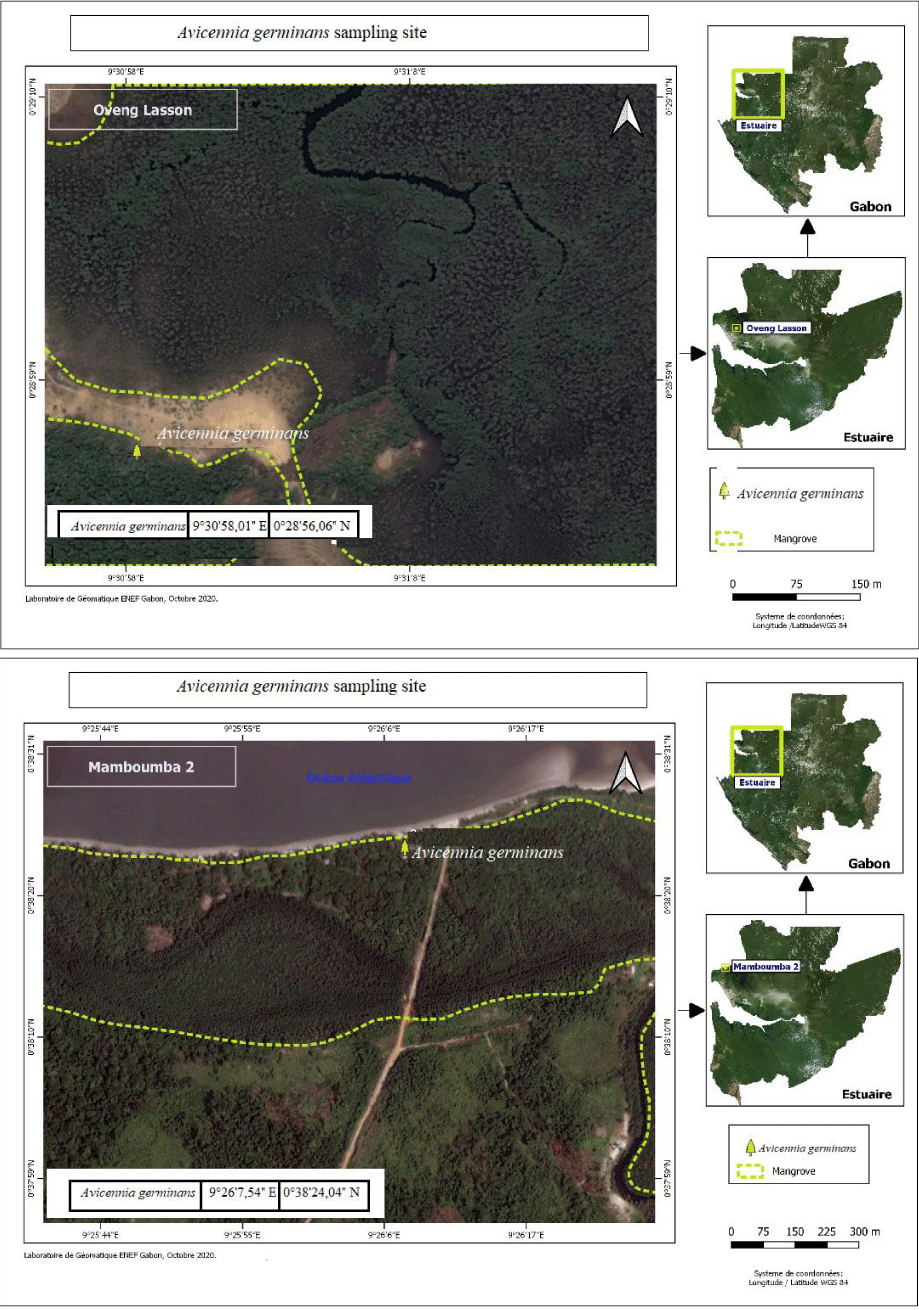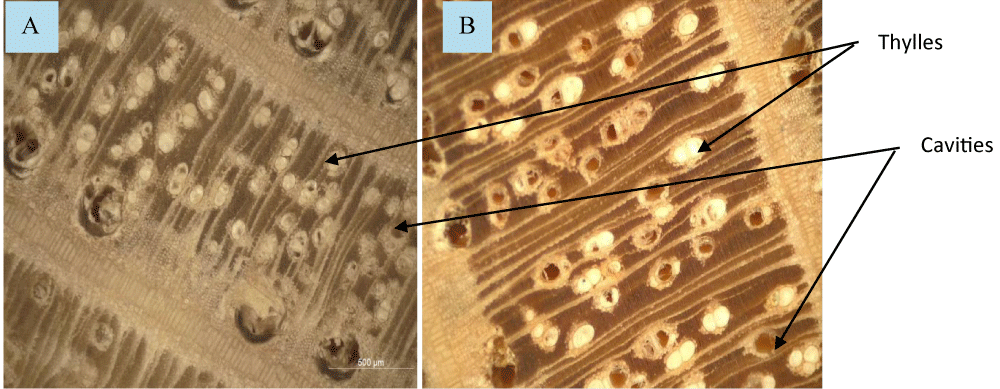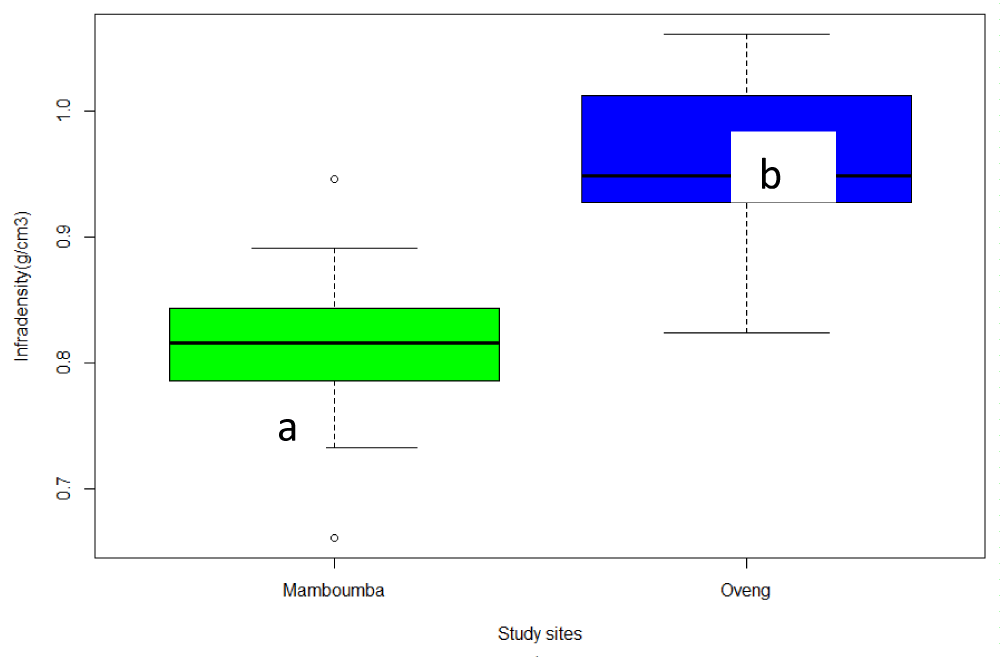Open Journal of Environmental Biology
Impact of Salinity on the Infradensity of Avicennia Germinans Wood Collected from Different Habitats in Greater Libreville
Mabicka Iwangou Saint Bickolard1,2*, Safou Tchiama Rodrigue3, Besserer Arnaud1, Masson Eric4, Andzi Barhé Timoléon5 and Gérardin Philippe1
1LERMAB, Faculty of Sciences and Technologies Boulevard des Aiguillettes, BP 70239.54506, Vandoeuvre lès Nancy Cedex, France
2Laboratory for Research and Valorization of Wood Material (LaReVa Bois), Thematic Research Group 1, Effect of Climate Change on the Quality of Wood and the Forests of the Congo Basin, Institute of Technological Research (IRT)/CENAREST, BP 9154, Libreville, Gabon
3Laboratory of Natural Substances and Organometallic Syntheses. Masuku University of Science and Technology, BP. 941, Franceville, Gabon
4CRITT bois, 27 rue Philippe Seguin, 88000 Epinal, France
5Applied Chemistry Research Laboratory (LACRA), Ecole Normale Supérieure (ENS), Marien Ngouabi University, Brazzaville, Congo
Cite this as
Saint Bickolard MI, Rodrigue ST, Arnaud B, Eric M, Timoléon AB, Philippe G. Impact of Salinity on the Infradensity of Avicennia Germinans Wood Collected from Different Habitats in Greater Libreville. Open J Environ Biol. 2024;9(1):025-029. Available from: 10.17352/ojeb.000044Copyright
© 2024 Saint Bickolard MI, et al. This is an open-access article distributed under the terms of the Creative Commons Attribution License, which permits unrestricted use, distribution, and reproduction in any medium, provided the original author and source are credited.Mangroves grow near the sea and inland. However, the mangroves that develop inland have a high and variable salinity. The salinity is a key factor in the anatomy of mangrove wood, this work aimed to show the impact of salinity on the vessel density, and the infradensity of Avicennia germinans (A. germinans). To do this, the trees of A. germinans were collected from the sites of Mamboumba (near the sea) and Oveng (inland), and analyses of vessel density and infradensity were performed in the laboratory. The results obtained show that the density of the vessels and the infradensity of heartwood, for example of A. germinans collected at the Oveng site are significantly higher with values of 38.11 ± 5.99 mm<-2 and 0.95 ± 0.06 g/cm3 respectively compared to 28.75 ± 8.19 mm<-2 and 0.81 ± 0.05 g/cm3 for A. germinans collected at the Mamboumba site. Also, we note that the vessels in Oveng wood are smaller than those in Mamboumba wood. This high salinity is responsible for the formation of small vessels and consequently for the increase in the infradensity of the A. germinans wood from the Oveng site.
Introduction
Mangroves are plants that grow in saline environments at the interface between land and sea in tropical climates. Mangroves also develop inland, notably in lagoons, rivers, and streams [1]. This interface position gives mangroves a very important ecological role. Among other things, they stabilize coasts against coastal erosion, they serve as nursery and breeding grounds for many species of fish and crustaceans, and they are the richest forests in terms of carbon, as mangrove forests sequester 3 times more carbon dioxide than other tropical forests [2,3]. However, mangroves growing inland have a higher salinity than those growing near the sea. Indeed, mangroves growing near the sea are inundated by seawater twice a day on average and have an almost constant salinity, unlike those growing inland, which have a variable salinity [4,5]. Salinity is a key factor in mangrove growth. Low salinities are favorable to mangrove growth, but high salinities compromise growth [6,7]. Also, salinity is a key factor for wood anatomy [8], and wood anatomy predicts the physical and mechanical properties of wood [9].
Gabon has six (6) species of mangroves: Rhizophora harrisonii, Rhizophora racemosa, Rhizophora mangle, Avicennia germinans, Cornocapus erectus, and Lagucularia racemosa. These mangroves grow near the sea and inland. These mangroves grow in different habitats, and therefore the conditions of the environment are not the same.
Despite the work carried out by the above authors, no studies have been carried out on the impact of salinity on the infradensity of A. germinans wood growing in these different habitats. This work aimed to show the impact of salinity on vessel density and infradensity of A. germinans wood growing near the sea and inland in Greater Libreville.
Material and methods
Experimental sites and sample harvesting
Avicennia germinans wood was collected from two experimental sites in the Greater Libreville area. The site of Oveng (00°28.8516'N; 009°30.9994'E) is located inland, while the site of Mamboumba (0°38'24.04 N; 9°26'754 E) is located near the sea in a protected area. At each site, 3 (three replications) A. germinans trees of similar diameter (70 cm - 80 cm) were harvested (Figure 1a,b).
Salinity measurement
Salinity was measured in situ at 15 cm soil depth using a multiparameter pH meter (portable 15-parameter multiparameter).
Light microscopy
The episcopic microscope coupled to a camera allows images to be obtained on wood samples (100 x to 700 x) using normal reflected light. The light is directed onto the sample by conical beams through the objective, providing an adjustable image of the structural details. To determine vessel density, twenty blocks of wood from each sapwood and heartwood compartment (1 cm3) were prepared. To obtain good surface quality, the transverse face of the sample was sanded with 4000 grit sandpaper (5 µm average grain size) and cleaned with compressed air. The wood blocks were then placed under a Leica DM2700M optical microscope equipped with a reflected light source and a digital camera for acquisition. A script was developed under FIJI software [10] for quantitative anatomy analysis. Some twenty wood samples were analyzed for each sample type.
Analysis of infradensity
Infradensity analysis was assessed according to Bakour [11]. Twenty-two 1 cm3 wood blocks from the Oveng and Mamboumba wood samples were machined from each sapwood and heartwood compartment., then oven-dried for 48 h at 103 °C. After vacuum saturation of the samples in a vacuum pump, they were weighed on a balance (Denver Instrument, max = 400 g, d = 0.001 g) using Archimedes' buoyancy. There were three replications for each compartment. Infradensity is the ratio between the mass of wood in its anhydrous state and its water-saturated volume or "green volume":
Where:
ρ = is the infradensity in g/cm3
M0 = oven-dry mass of the wood,
Vs = saturated volume.
Data analysis
All data were analyzed using Student's t-test at a significance level ὰ = 0.05.
Results
Macroscopic and microscopic differences
The heartwood diameter of A. germinans from Mamboumba was small compared with that from Oveng, and they have different colors. The heartwood of Oveng wood is dark grey, whereas the heartwood of Mamboumba wood is dark yellow Figure 2c,d. This difference can be explained by the difference in habitats where these mangroves develop. Indeed, mangroves growing near the sea do not grow under the same conditions as those growing inland [5,12].
Figures 3A,B and 4C,D show the color differences in the cross-sections and the condition of the sapwood and heartwood vessels of A. germinans sampled from the various sites mentioned above. In general, heartwood is darker than sapwood. A comparison of the sapwood and heartwood of the different sites reveals that there is a color difference. The sapwood of the Oveng wood is dark brown, while the sapwood of the Mamboumba wood is light brown.
Vessel density
Mangroves develop in saline environments. And salinity varies from station to station. Salinity is a major factor in mangrove wood anatomy [8]. The effects of salinity variations were observed on Avicennia germinans wood from Mamboumba and Oveng. These sites have salinities of 16.24 g/L and 35.36 g/L respectively. The results showed that vessel density and sediment salinity were correlated. sapwood vessel density of oven wood is significantly higher (p < 0.05) than that Mamboumba sapwood with values of 48 ± 11,52 mm<-2 and 31 ± 4,29 mm<-2 respectively (Figure 5E). Similarly, the vessel density of oveng heartwood is significantly higher (p < 0.05) than that of Mamboumba heartwood with values of 38.11 ± 5.99 mm<-2 and 28.75 ± 8.19 mm -2 respectively (Figure 5F).
Infradensity
On a microscopic scale, the void in the wood corresponds to the lumen in the fibers and vessels, and this lumen has an impact on the physicomechanical properties of mangroves. Although sapwood samples from the Mamboumba site are characterized by a lower infradensity (0.70 ± 0.02 g/cm3) than that of Oveng wood (0.69 ± 0.003g/cm3), but the difference is not significant (p ˃ 0.05) (Figure 6). However, the infradensity of heartwood from Mamboumba (0.81 ± 0.05 g/cm3) is significantly lower (p < 0.0001) than that of wood from Oveng (0.95 ± 0.06 g/cm3) (Figure 7).
Discussion
Differences observed on cross-sections
Mangroves thrive in different habitats. Figures 3,4 show the difference in color of cross-sections of sapwood and heartwood of A. germinans collected at the Mamboumba and Oveng sites. This color difference can be explained by the nature of the substrate, among other factors. The Mamboumba site is close to the sea, while the Oveng site is inland, with rocky soil and limestone deposited in blocks by erosion dating from the Turanian (Upper Cretaceous). The total obstruction of the vessels on the heartwood cross-sections by thylls is because during duraminization, parenchyma cells elaborate thylls among others, and these thylls obstruct the vessels and prevent the circulation of water and mineral salts. This is why heartwood is referred to as dead wood. However, the formation of thylls does not necessarily accompany duramnization; it can occur long before, hence the observation of thylls in the sapwood. (Figure 2A,B) [9,13].
Vessel density
Soil salinity at Oveng is higher than at the Mamboumba site. This difference in salinity with its corollary on vessel density. Robert, et al. [12] indicated that vessel density in mangrove woodland increased under high salinity conditions. This is why the vessel density of the sapwood and heartwood of Oveng wood is significantly higher than that of the sapwood and heartwood of Mamboumba wood (Figure 4). This can be explained by the nature of the substrate. Mangroves growing near the sea have a lower salinity than those growing inland, due to the amount of salt stored in the soil, which varies according to soil type, being low for sandy soils and high for clay soils. In sandy soils, water quickly seeps through to the surface water table because the pores are too large, whereas clay soils, with their small pore size, absorb a lot of water [12,14]. In addition, the vessels of Oveng wood appear smaller than those of Mamboumba wood. In high-salinity zones, there is an increase in vessel density and a decrease in vessel diameter for Avicennia marina, Rhizophora. mucronata and Laguncularia racemosa, whereas in low-salinity conditions, mangroves have low vessel density and larger vessels [15,16].
Infradensity
Unlike Figure 6, which shows that the infradensity of A. germinans sapwood from the Oveng site is not significantly different from that of sapwood from the Mamboumba site (p ˃ 0.05), Figure7 shows that there is a significant difference between A. germinans duramen from the different sites (p ˂ 0.0001). This non-significant difference for sapwood can be explained by the fact that sapwood is the living part of the wood, facilitating the circulation of raw sap to the leaves through certain vessels unobstructed by thylls, which increases the percentage of void in the wood [9]. On the other hand, the decrease in heartwood infradensity at Mamboumba could be explained by the increase in wood void space, which is closely linked to environmental conditions such as salinity. The Avicennia genus is a diffusely pored wood for its lumen occupies the entire vessel’s wall. The vessels’ diameter of the wood from the Mamboumba site appears larger than the Oveng ones. This difference in vessels’ diameters may explain the significant decrease in infradensity of the wood from the Oveng site, for the vessels’ diameter is linked to soil salinity. High salinity provokes narrow vessels’ diameter [15]. Salinity also influences the mangrove’s wood density which is linked to the fibers’ wall thickness and the reduction of the vessels’ lumen diameter; both depend on the salinity content. Yanez – Espinoza, et al. [4](2009) reported that in the areas of low salinity, A. germinans has a low fibers’ thickness, its wood collected from sites of 30.09‰ and 12.57 ‰ salinity exhibited fibers’ wall thicknesses around 4.8 μm (with a vessel lumen diameter of 3.2μm) and 3.8 μm (with a vessel lumen diameter of 5.5 μm), respectively.
Conclusion
The objective of this work was to show the impact of salinity on the density of the vessels and the infradensity of the wood of A. germinans which develops near the sea and inland. In short, salinity varies according to habitat. Mangroves growing inland have a higher soil salinity than those growing near the sea. This higher salinity results in greater vessel density, narrower vessel diameter, and higher infradensity. We also found that sapwood cross-sections were partially obstructed by thylls, while heartwood cross-sections were obstructed by thylls, making the heartwood the dead wood.
This research was possible as a result of the RIFFEAC (Réseau des Institutions de Formation Forestière et Environnementale en Afrique centrale) Master of Science degree in Wood Sciences scholarship program. The authors thank also the Sylvatech imaging technical platform of INRAe for the mineral analysis. The EDGE (Ecole Doctorale des Grandes Ecoles de Libreville) is thanked for its administrative support and facilities. LaReVa Bois (Laboratoire de Recherche et de Valorisation du Matériau Bois) and ENEF Gabon (Ecole Nationale des Eaux et Forêts) are thanked for the technical and scientific support brought to this research. LERMAB is thanked for its scientific, and technical support and wood scientists network mobilized for the fulfillment of this PhD thesis program.
- Ngom Sow F. The functions of the mangrove in the structuring and biology of fish populations in the Sine-Saloum Estuary (Senegal-West Africa). Doctoral thesis. Cheik Anta Diop University of Dakar. 2005;148. Available from: https://www.sciepub.com/reference/375466
- Poirier A. The vulnerability of ocean carbon sinks to ocean acidification. University of Sherbrooke: Double degree essay presented to the Department of Biology and the University Center for Environmental Training with a view to obtaining the degrees of master in international ecology and master in environment. 2013. Available from: https://savoirs.usherbrooke.ca/bitstream/handle/11143/7396/cufe_Poirier_AG__2013-06-25_essai391.pdf;sequence=1
- Donato DC, Kauffman JB, Murdiyarso D, Kurnianto S, Stidham M, Kanninen M. Mangroves are among the most carbon-rich forests in the tropics. Nature Geoscience. 2011;4:293-297. Available from: https://www.nature.com/articles/ngeo1123
- Yáñez Espinosa L, Angeles G, López Portillo J, Barrales S. Anatomical variation of Avicennia germinans wood in Laguna de la Mancha, Veracruz, Mexico. Bot. Sci. 2009;85:7-15. Available from: https://doi.org/10.17129/botsci.2298
- Naidoo G. Factors contributing to dwarfing in the mangrove Avicennia marina. Annals of Botany. 2006;97:1105-1095. Available from: http://dx.doi.org/10.1093/aob/mcl064
- Naidoo G. Effects of nitrate, ammonium, and salinity on the growth of the mangrove Bruguiera gymnorrhiza (L.) Lam. Aquatic Botany. 1990;38(2-3):209-219. Available from: http://dx.doi.org/10.1016/0304-3770(90)90006-7
- Triwilaida Intari SE. Factors affecting the death of mangrove trees in the Pedada Strait, Indragiri Hilir, Riau, with reference to the site conditions. Bulletin Penelitian Hutan. 1990;531:33-48. https://agris.fao.org/search/en/providers/122456/records/6471e9fd77fd37171a70e59d
- Parida AK, Jha B. Salt tolerance mechanisms in mangroves: a review. Trees. 2010;24:199-217. Available from: https://doi.org/10.1007/s00468-010-0417-x
- Trouy MC. Anatomie du bois. Formation, fonctions et identification. Edition Quae. Paris. 2015;6. Available from: https://www.researchgate.net/publication/283010666_Anatomie_du_bois_Formation_fonctions_et_identification
- Schindelin J, Arganda-Carreras I, Frise E, Kaynig V, Longair M, Pietzsch T, et al. Fiji: an open-source platform for biological-image analysis. Nature Methods. 2012;9:676-682. Available from: https://doi.org/10.1038/nmeth.2019
- Bakour R. Influence of the oak species and the origin of the two main French oaks (Quercus robur L. and Quercus petraea Liebl.) on the anatomical structure and physical properties of stave wood. Doctoral thesis. Forestry and wood sciences. Nancy: National School of Rural Engineering, Water and Forests. 2003;250. Available from: https://theses.hal.science/pastel-00000871/
- Robert EMR, Koedam N, Beeckman H, Schmitz N. A safe hydraulic architecture as wood anatomical explanation for the difference in distribution of the mangroves Avicennia and Rhizophora. Functional Ecology. 2009;23:649-657. Available from: https://doi.org/10.1111/j.1365-2435.2009.01551.x
- Tatjana S, Dominique P. Wood Chemistry. Polytechnic and university presses; 2009. Available from: https://www.mollat.com/livres/37083/tatjana-stevanovic-chimie-du-bois
- Noomene H. Etude de la salinité des sols par la détection électromagnétique dans le périmètre irrigué de Kalacat Landelous en Tunisie: cas d’une parcelle de courge. 2011. Available from: https://www.memoireonline.com/11/13/7973/Etude-de-la-salinite-des-sols-par-la-methode-de-detection-electromagnetique-dans-le-perimetre.html
- Verheyden A, De Ridder F, Schmitz N, Beeckman H, Koedam N. High-resolution time series of vessel density in Kenyan mangrove trees reveal a link with climate. New Phytologist. 2005;167:425-435. Available from: https://doi.org/10.1111/j.1469-8137.2005.01415.x
- Schmitz N, Robert EMR, Verheyden A, Kairo JG, Beeckman H, Koedam N. A Patchy Growth via Successive and Simultaneous Cambia: Key to Success of the Most Widespread Mangrove Species Avicennia marina? Ann Bot. 2008;101:49–58. Available from: https://doi.org/10.1093/aob/mcm280

Article Alerts
Subscribe to our articles alerts and stay tuned.
 This work is licensed under a Creative Commons Attribution 4.0 International License.
This work is licensed under a Creative Commons Attribution 4.0 International License.







 Save to Mendeley
Save to Mendeley
